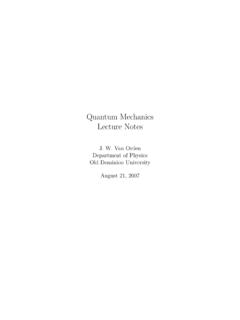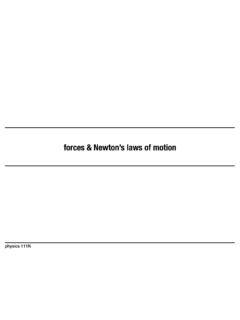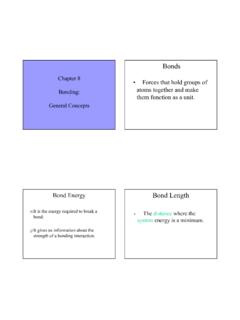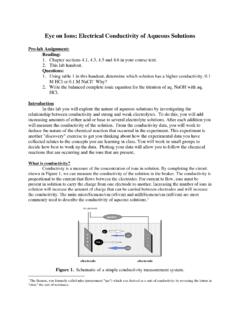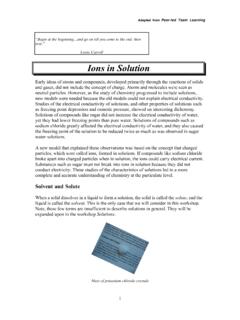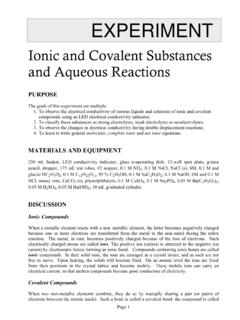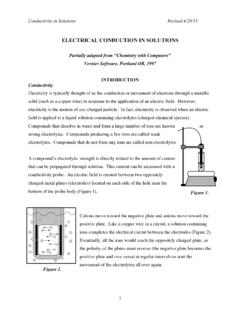Transcription of Aqueous Solutions - ODU
1 1 Types of Chemical ReactionsandSolution StoichiometryAqueous SolutionsWater is the dissolving medium, or Properties of Water Water is bent or V-shaped. The O-H bonds are covalent. Water is a polar molecule. Hydration occurs when salts dissolve in : (Left) The water molecule is polar. (Right) A space-filling model of the water : (a) The ethanol molecule contains a polar O H bond similar to those in the water molecule. (b) The polar water molecule interacts strongly with the polar O H bond in ethanol. This is a case of "like dissolving like."A Solute dissolves in water (or other solvent ) changes phase (if different from the solvent) is present in lesser amount (if the same phase as the solvent)2A Solvent retains its phase (if different from the solute) is present in greater amount (if the same phase as the solute)Ions in Aqueous Solution Some molecular compounds dissolve but do not dissociate into ions.
2 Aq(OHC )glucose( )s(OHC6126 OH 61262 Ionic Theory of Solutions These compounds are referred to dissolve in water to give in Aqueous Solution Many ionic compounds dissociateinto independent ions when dissolved in waterIonic Theory of Solutions These compounds that freely dissociate into independent ions in Aqueous solution are called electrolytes. Their Aqueous Solutions are capable of conducting an electric current. )aq(Cl)aq(Na)s(NaClOH2 ++ Figure : Polar water molecules interact with the positive and negative ions of a salt assisting in the dissolving : When solid NaCl dissolves, the Na+and Cl-ions are randomly dispersed in the in solution conduct electricity. Strong electrolytes insolution conduct electricity!)
3 ElectrolytesStrong - conduct current efficientlyNaCl, HNO3 Weak - conduct only a small currentvinegar, tap waterNon - no current flowspure water, sugar solution3 Figure : electrical conductivity of Aqueous Solutions . Thus, in general, ionic solidsthat dissolve in water are electrolytes. Somemolecular compounds,such as acids, also dissociate in Aqueous solution and are considered in Aqueous Solution Electrolytes are substances that dissolve in water to give an electrically conducting Theory of SolutionsHCl (aq) H+(aq) + Cl-(aq)Figure : HCl(aq) is completely acids - dissociate completely to produce H+in solutionhydrochloric and sulfuric acidWeak acids - dissociate to a slight extentto give H+in solutionacetic and formic acidFigure : Acetic acid (HC2H3O2) exists in water mostly as undissociated molecules.
4 Only a small percentage of the molecules are bases - react completelywith water to give OH hydroxideWeak bases - react only slightlywith water to give OH : An Aqueous solution of sodium in Aqueous Solution Strong and weak electrolytes. A weak electrolyteis an electrolyte that dissolves in water to give a relatively small percentage of ions. NH3(g) + H2O (l) NH4OH (aq) )aq(OH)aq(NH )aq(OHNH44 ++ Most soluble molecular compounds are either nonelectrolytesor weak Theory of SolutionsFigure : The reaction of NH3in in Aqueous Solution In summary, substances that dissolve in water are either electrolytesor Theory of Solutions : Summary Nonelectrolytesform nonconducting Solutions because they dissolve as molecules.
5 Electrolytesform conducting Solutions because they dissolve as in Aqueous Solution Electrolytes can be strongor weak. Almost all ionic substances that dissolve are strong electrolytes. Molecular substances that dissolve are either nonelectrolytesor weak Theory of Solutions : SummaryWorking with Solutions Molar concentration, ormolarity (M),is defined as the moles of solute dissolved in one liter (cubic decimeter) of Concentrationsolution of literssolute of moles(M) Molarity=5 MolarityMolarity (M) = moles of solute per volume of solution in liters:MM===molaritymoles of soluteliters of solutionHClmoles of HClliters of solution362 Common Terms of Solution ConcentrationStock- routinely used Solutions prepared in concentrated ratio of solute to solvent.
6 ( MNaCl)Dilute-relativelysmall ratio of solute to solvent. ( MNaCl)Working with Solutions The majority of chemical reactions discussed here occur in Aqueous solution. When you run reactions in liquid Solutions , it is convenient to dispense the amounts of reactants by measuring outvolumesof reactant : (a) A measuring pipet is graduated and can be used to measure various volumes of liquid accurately. (b) a volumetric (transfer) pipet is designed to measure one volume : Steps involved in the preparation of a standard Aqueous with Solutions When we dissolve a substance in a liquid, we call the substance the soluteand the liquid the Concentration The general term concentrationrefers to the quantity of solute in a standard quantity of with SolutionsMolar Concentration A sample of mol iron(III) chloride, FeCl3, was dissolved in water to give mLof solution.
7 What is the molarity of the solution? Let s try an example. Sincesolution of litersFeCl of molesmolarity3=then33 FeCl M ofliter of mole with SolutionsHow many moles of Cl-are in L of M FeCl3solution? moles FeCl3x 3 moles Cl-x L soln = moles L soln. 1 mole FeCl3 FeCl3(s) Fe3+(aq)+ 3 Cl-(aq)H2 OWorking with SolutionsFrom the equation moles of solute = MolarityLiters of solutionMoles = M or, rearranging: L x M = molesLHow many moles of NaCl are in ml of MNaCl solution?First, convert ml to L: ml x 10-3L/ml = ml( L soln) ( moles NaCl/L soln) = molesNaCl Working with Solutions The molarityof a solution and its volumeare inversely proportional. Therefore, adding water makes the solution less Solutions This inverse relationship takes the form of:ffiiVMVM = So, as water is added, increasing the final volume,Vf, the final molarity, Mf, = MolesHow many liters of M HCl will be neededto prepare L of M HCl?
8 Use MiVi= MfVfWe want to solve for ViMi= M HClMf= M HClVf= L HClSolving the equation for ViVi = (MfVf)/ Mi= ( M x L)/( M) = LFigure : Dilution Procedure(a) About 100 mL of water is added to a 500 mL flask.(b) A measuring pipet is then used to transfer 375 of MHCl solution to a volumetric flask. (c) Water is added to the flask to the calibration mark. (d) The resulting solution is M addacids to waterto preventviolent boiling!7 Types of Solution Reactions Precipitation reactionsAgNO3(aq) + NaCl(aq) AgCl(s) + NaNO3(aq) Acid-base reactionsNaOH(aq) + HCl(aq) NaCl(aq) + H2O(l) Oxidation-reduction reactionsFe2O3(s) + 2 Al(s) 2 Fe(s) + Al2O3(s)Ions in Aqueous Solution A molecular equationis one in which the reactants and products are written as if they were molecules, even though they may actually exist in solution as and Ionic Equations Note that Ca(OH)2, Na2CO3, and NaOH are all soluble compounds but CaCO3is not.
9 +)aq(CONa)aq()OH(Ca322)aq(NaOH2)s(CaCO3+ Simple Rules for Solubility1. Most nitrate (NO3 ) salts are Most alkali (group 1A) salts and NH4+are Most Cl , Br , and I salts are soluble (NOT Ag+, Pb2+, Hg22+)4. Most sulfate salts are soluble (NOT BaSO4, PbSO4, HgSO4, CaSO4)5. Most OH salts are only slightly soluble (NaOH, KOH are soluble, Ba(OH)2, Ca(OH)2are marginally soluble)6. Most S2 , CO32 , CrO42 , PO43 salts are only slightly soluble. Ions in Aqueous Solution An ionic equation, however, represents strong electrolytes as separate independent ions. This is a more accurate representation of the way electrolytes behave in and Ionic Equations +++ + +)aq(CO)aq(Na2)aq(OH2)aq(Ca232)aq(OH2)aq (Na2)s(CaCO3 +++ A complete ionic equationis a chemical equation in which strong electrolytes (such as soluble ionic compounds) are written as separate ions in in Aqueous Solution Complete and net ionic equationsMolecular and Ionic Equations +++ + +)aq(CO)aq(K2)aq(NO2)aq(Ca2332 +)aq(COK)aq()NO(Ca3223(strong)(strong)(s trong)(insoluble))aq(KNO2)s(CaCO33+)aq(N O2)aq(K2)s(CaCO33 +++Ions in Aqueous Solution Complete and net ionic and Ionic Equations A net ionic equationis a chemical equation from which the spectator ions have been removed.
10 A spectator ionis an ion in an ionic equationthat does not take part in the reaction. +++ + +)aq(CO)aq(K2)aq(NO2)aq(Ca2332)aq(NO2)aq (K2)s(CaCO33 +++8 Ions in Aqueous Solution Complete and net ionic equations Separating the strong electrolytes into separate ions, we obtain the complete ionic and Ionic Equations ++ +)s()OH(Mg)aq(NO2)aq(H223)aq(NO2)aq(Mg)l (OH2322 +++ Note that the nitrate ions did not participate in the reaction. These are spectator in Aqueous Solution Complete and net ionic equations Eliminating the spectator ions results in the net ionic and Ionic Equations ++ +)s()OH(Mg)aq(NO2)aq(H223)aq(NO2)aq(Mg)l (OH2322 +++)aq(Mg)l(OH2)s()OH(Mg)aq(H2222+++ +This equation represents the essential : Precipitation of silver chloride by mixing Solutions of silver nitrate and potassium chloride.

